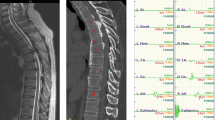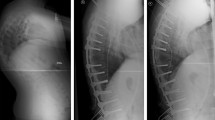Abstract
Purpose
To optimize intraoperative neuromonitoring during extreme lateral interbody fusion (XLIF) by adding transcranial electrical stimulation with motor evoked potential (TESMEP) to previously described monitoring using spontaneous EMG (sEMG) and peripheral stimulation (triggered EMG: tEMG).
Methods
Twenty-three patients with degenerative lumbar scoliosis had XLIF procedures and were monitored using sEMG, tEMG and TESMEP. Spontaneous and triggered muscle activity, and the MEP of 5 ipsilateral leg muscles, 2 contralateral leg muscles and 1 arm muscle were monitored.
Results
During XLIF surgery decreased MEP amplitudes were measured in 9 patients and in 6 patients sEMG was documented. In 4 patients, both events were described. In 30 % of the cases (n = 7), the MEP amplitude decreased immediately after breaking of the table and even before skin incision. After reduction of the table break, the MEP amplitudes recovered to baseline. In two patients, the MEP amplitude deteriorated during distraction of the psoas with the retractor, while no events were reported using sEMG and tEMG. Repositioning of the retractor led to recovery of the MEP.
Conclusions
Monitoring the complete nervous system during an XLIF procedure is found to be helpful since nerve roots, lumbar plexus as well as the intradural neural structures may be at risk. TESMEP has additional value to sEMG and tEMG during XLIF procedure: (1) it informed about otherwise unnoticed events, and (2) it confirmed and added information to events measured using sEMG.

Similar content being viewed by others
References
Bendersky M, Solá C, Muntadas J, Gruenberg M, Calligaris S, Mereles M, Valacco M, Bassani J, Nicolás M (2015) Monitoring lumbar plexus integrity in extreme lateral transpsoas approaches to the lumbar spine: a new protocol with anatomical bases. Eur Spin J 24:1051–1057. doi:10.1007/s00586-015-3801-9
Benglis DM, Vanni S, Levi AD (2009) An anatomical study of the lumbosacral plexus as related to the minimally invasive transpsoas approach to the lumbar spine. J Neurosurg Spine 10(2):139–144. doi:10.3171/2008.10.SPI08479
Berjano P, Lamartina C (2013) Far lateral approaches (XLIF) in adult scoliosis. Eur Spine J 22(Suppl 2):S242–S253. doi:10.1007/s00586-012-2426-5
Cahill KS, Martinez JL, Wang MY, Vanni S, Levi AD (2012) Motor nerve injuries following the minimally invasive lateral transpoas approach. J Neurosurg Spine 17(3):227–231. doi:10.3171/2012.5.SPINE1288
Dakwar E, Cardona RF, Smith DA, Uribe JS (2010) Early outcomes and safety of the minimally invasive, lateral retroperitoneal transpsoas approach for adult degenerative scoliosis. Neurosurg Focus 28(3):E8. doi:10.3171/2010.1
Gazzeri R, Faiola A, Neroni M, Fiore C, Callovini G, Pischedda M, Galarza M (2013) Safety of intraoperative electrophysiological monitoring (TES and EMG) for spinal and cranial lesions. Surg Technol Int 23:296–306
Grimm BD, Leas DP, Poletti SC, Johnson DR 2nd (2014) Postoperative complications within the first year after extreme lateral interbody fusion: experience of the first 108 patients. J Spinal Disord Tech. doi:10.1097/BSD.0000000000000121
Guérin P, Obeid I, Bourghli A, Masquefa T, Luc S, Gille O, Pointillart V, Vital J-M (2012) The lumbosacral plexus: anatomic consideration for minimally invasive retroperitoneal transpsoas approach. Surg Radiol Anat 34:151–157. doi:10.1007/s00276-011-0881-z
Houten JK, Alexandre LC, Nasser R, Wollowick AL (2011) Nerve infury during the transpsoas approach for lumbar fusion. Report of 2 cases. J Neurosurg Spine 15:280–284. doi:10.3171/2011.4.SPINE1127
Hrabalek L, Adamus M, Gryga A, Wanek T, Tucek P (2014) A comparison of complication rate between anterior and lateral approaches to the lumbar spine. Biomed Pap Med Fac Univ Palacky Olomouc Czech Repub 158(1):127–132. doi:10.5507/pb.2012.079
Journée HL, Polak HE, de Kleuver M (2004) Influence of electrode impedance on threshold voltage for transcranial electrical stimulation in motor evoked potential monitoring. Med Biol Eng Comput 42(4):557–561
Knight RQ, Schwaegler P, Hanscom D, Roh J (2009) Direct lateral lumbar interbody fusion for degenerative conditions. Early complication Profile. J Spinal Disord Tech 22:34–37. doi:10.1097/BSD.0b013e3181679b8a
Malham GM, Ellis NJ, Parker RM, Seex KA (2012) Clinical outcome and fusion rates after the first 20 extreme lateral interbody fusions. Sci World J. doi:10.1100/2012/246989 (246989)
Moro T, Kiluchi S, Konno S, Yaginuma H (2003) An anatomic study of the lumbar plexus with respect to retroperitoneal endoscopic surgery. Spine 28:423–428
Papanastassiou ID, Eleraky M, Vrionis FD (2011) Contralateral femoral nerve compression: an unrecognized complication after extreme lateral interbody fusion (XLIF). J Clin Neurosci 18(1):149–151. doi:10.1016/j.jocn.2010.07.109
Park DK, Lee MJ, Lin EL, Singh K, An HS, Philips FM (2010) The relationship of intrapsoas nerves during a transpsoas approach to the lumbar spine. Anatomic study. J Spinal Disord Tech 23:223–228. doi:10.1097/BSD.0b013e3181a9d540
Rodgers WB, Gerber EJ, Patterson J (2011) Intraoperative and early postoperative complications in extreme lateral interbody fusion. Spine 36(1):26–32. doi:10.10907/BRS.0b013e3181e1040a
Rodgers WB, Lehmen JA, Gerber EJ, Rodgers JA (2012) Grade 2 spondylolisthesis at L4-5 treated by XLIF: safety and midterm results in the “worst case scenario”. Sci World J. doi:10.1100/2012/356712 (356712)
Schirmer CM, Shils JL, Arle JE, Cosgrove GR, Dempsey PK, Tarlov E, Kim S, Martin CJ, Feltz C, Moul M, Magge S (2011) Heuristic map of myotomal innervation in humans using direct intraoperative nerve root stimulation. J Neurosurg Spine 15:64–70. doi:10.3171/2011.2.SPINE1068
Tohmeh AG, Rodgers WB, Peterson MD (2011) Dynamically evoked, discrete-threshold electromyography in the extreme lateral interbody fusion approach. J Neurosurg Spine 14:31–37. doi:10.3171/2010.9
Tormenti MJ, Maserati MB, Bonfield CM, Okonkwo DO, Kanter AS (2010) Complications and radiographic correction in adult scoliosis following combined transpoas extreme lateral interbody fusion and posterior pedicle screw instrumentation. Neurosurg Focus 28(3):E7. doi:10.3171/2010.1
Uribe JS, Vale FL, Dakwar E (2010) Electromyographic monitoring and its anatomical implications in minimally invasive spine surgery. Spine 35(16 Suppl):S368–S374. doi:10.1097/BRS.0b013e3182027976
Uribe JS, Isaacs RE, Youssef JA, Khajavi K, Balzer JR, Kanter AS, Küelling FA, Peterson MD (2015) Eur Spine J 24(suppl 3):S379–S385. doi:10.1007/s00586-015-3871-8
Author information
Authors and Affiliations
Corresponding author
Ethics declarations
Conflict of interest
The authors declare that they have no conflict of interest.
Funding
AOSpine TK system funded the study. We thank them for providing the financial support.
Rights and permissions
About this article
Cite this article
Berends, H.I., Journée, H.L., Rácz, I. et al. Multimodality intraoperative neuromonitoring in extreme lateral interbody fusion. Transcranial electrical stimulation as indispensable rearview. Eur Spine J 25, 1581–1586 (2016). https://doi.org/10.1007/s00586-015-4182-9
Received:
Revised:
Accepted:
Published:
Issue Date:
DOI: https://doi.org/10.1007/s00586-015-4182-9




